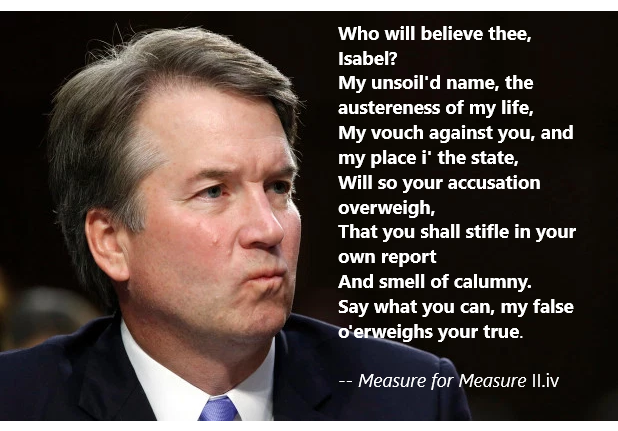There’s a lot going on today. The FBI caught a white militia in an attempt to kidnap Michigan governor Gretchen Whitmer, evidently believing they were carrying out Trump’s orders to “LIBERATE MICHIGAN.” Trump’s team is throwing a tantrum over the Commission on Presidential Debates’ decision to make the next debate virtual due to Trump and his team being contagious with a dangerous virus. In an astonishingly dimwitted move, the campaign released a letter denouncing CPD for “trying to protect Joe Biden” (and, one assumes, themselves and everyone who works at the venue). Senator Mike Lee (R-Utah) tweeted that he’s against democracy because it “thwarts liberty, peace, and prospefity.” (Ah, prospefity, one of the cofnefstones of ouf gfeat country.)
But one thing passed quickly this morning that needs a closer look: Trump twice called Senator Kamala Harris “this monster.” I know it seems like just one more thing to toss on the 25th Amendment pile, but it bears particular scrutiny.
We’ve already seen conservatives (and even some men on the left) pull out every ugly sexist attack in the Tired Old Playbook of Sexist Attacks. Harris is a “madwoman,” a “slut” who “slept her way to the top,” she’s ugly, her voice is “shrill” and “grating.” She’s “ambitious,” which is only a slur when applied to women; when applied to men, it’s a compliment. After the Vice Presidential debate, conservative men– let’s call them “con men” for short– flooded social media with declarations of Harris’ “unlikeability.” That’s truly my favorite. These con men mean she’s “unlikeable” to them. The kind of man who uses that term is, invariably, intimidated by strong, smart women because they’re afraid (usually for good reason) that the women are stronger and smarter than they are.
“Monster” has been used against women dating back to the fight for women’s suffrage. Women who rejected the idea that women are inferior to men, should be ruled by their husbands, and exist to serve men have historically been called “monsters” whose “monstrosity” is a destructive force against “the American family” and “the American way of life.” Senator Harris, as a powerful, brilliant woman who does not suffer fools gladly, is, to these frightened little men, a “monster.”
But to these frightened little con men, Kamala Harris isn’t just a woman– she’s a woman of color. She’s mixed race– her father is a Black man who immigrated from Jamaica and her mother was an Asian woman who immigrated from India.
When a man like Donald Trump calls Harris “this monster,” he’s not only using a term with a long, sexist history; he’s deploying a racial slur that has been used against both people of color and mixed-race people for hundreds of years.
“This monster” means she’s not human but sub-human, unworthy of the consideration we owe other human beings. Dangerous, malevolent. “This monster” is a weapon intended to dehumanize.
Dehumanization is the centerpiece of racism. Monstrosity has been attributed to both Black and Asian people throughout US history. It was used as a justification for slavery– these “savage monsters” would become a destructive force if left “uncontrolled,” raping white women and murdering children in their cradles, without the “guidance” of white enslavers. It underpinned the “yellow peril”– these “monsters” are “ruthless” and “heartless” sub-human dangers to upstanding Americans. Brown-skinned people, regardless of culture or ethnicity, were called “monster” after 9/11. “These monsters want to destroy America,” white people say when they attack– and kill– Sikhs in turbans, as far from being Al Qaeda as a white American is from being a White Guelph. These attacks surged after 9/11 and have been increasing, unsurprisingly, in the Trump era, as all racist attacks have been increasing, emboldened by their racist leader tweeting his racism, airing it on television, trumpeting it from the very steps of the White House. “We” are human; “they” are monsters.
What’s particularly potent in Trump calling Harris “this monster” is that “monster” has been used for generations as a particular slur against mixed-race people. They don’t “belong” to any one race or ethnicity; they’re “monsters” who don’t belong to any human category, an “unnatural” amalgamation that goes against the “law of God.” This argument was used to justify slavery (abolishing slavery would lead to interracial unions and “monster” children), and then again to justify bans on interracial marriage (again, “monster” children). It’s in use right now, in far-right circles, about mixed-race people. The far right is, right this second, justifying white supremacy and the “purity” of the “white race” by calling mixed-race children “monsters.”
Donald Trump knows as well as any racist and sexist what it means to call a mixed-race female Senator a “monster.”
As with everything in modern conservatism, accusations are confessions. Trump claims Biden and Harris are “liars” and “corrupt,” that Biden is “lazy” and “losing it”– all things that Trump himself is, as the impartial observers outside the US, aghast at what’s happening in America, often discuss. So Trump predictably defends against the widespread claim that he, and the GOP he bullied into his own image, are “monsters” due to their monstrous behavior by calling Senator Harris a “monster,” but the two are not equivalent. Trump and his GOP are monstrous in their speech and actions.
Trump calls Senator Harris “this monster” because he’s using racism and sexism to appeal to his base, and that racism and sexism makes him, in a word, monstrous.




















